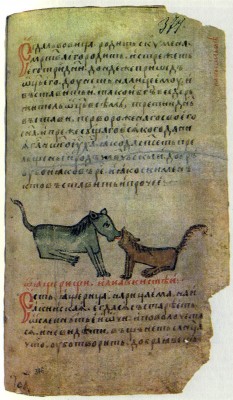The Physiologos
Whereas the hехаёmeron was about nature as a whole, from heavenly bodies to plants and animals, another work, The Physiologos, dealt primarily with living creatures, both real (the lion, eagle, ant, whale, elephant, etc.) and imaginary (the phoenix, the siren, the centaur), and a few plants or precious stones (diamonds, flints, magnets and others).
Each account listed the properties of the creature or object, and then gave a symbolical interpretation of these properties. As a rule, however, the descriptions of animals, and particularly of plants or stones, are quite fantastic in The Physiologos, because the main aim was to find an analogy between the properties of the creature or object and some theological concept.35

Illumination from The Physiologos. 15th century. A Lion Breathing Life Into New-Born Cub. State Public Library, Leningrad
Thus, for example, it says that when pelicans are born they begin to peck their parents until the latter are driven to killing them. After mourning their children for three days, the mother pierces her rib and her blood drips onto the young bringing them to life again. The behaviour of the pelican, The Physiologos declares, symbolises the fate of mankind which fell into sin, but was saved by Christ’s blood shed for it. In the same way the fantastic story about lions (that the lioness gives birth to dead cubs, and the father brings them to life after three days by breathing on them) is also connected with the incarnation, death and resurrection of Christ.
Nevertheless these stories about animals are, as a rule, extremely entertaining: thus, it also says that the lion sleeps with its eyes open; the crocodile weeps as it devours its prey; the phoenix sets fire to itself on the altar, and a worm emerges from the ashes that turns into a fledgeling on the second day and a fully-grown bird on the third.
It also describes the behaviour of the fox: it pretends to be dead, and as soon as the birds alight and begin to peck it, it jumps up and catches them. The salamander, according to The Physiologos, puts out fire by entering it. Some redactions of the work say that after the death of its mate the lonely turtle-dove sits on a withered tree “lamenting its friend”.36
We do not know of any manuscripts of The Physiologos before the beginning of the fifteenth century, but we can assume that there was a translation of it in Kievan Russia. It is interesting that in a letter from Prince Vladimir Monomachos of Kiev (who died in 1125) we find the same image of a turtle-dove weeping on a withered tree used to describe his dead son’s widow.
 History of Russian Literature
History of Russian Literature
